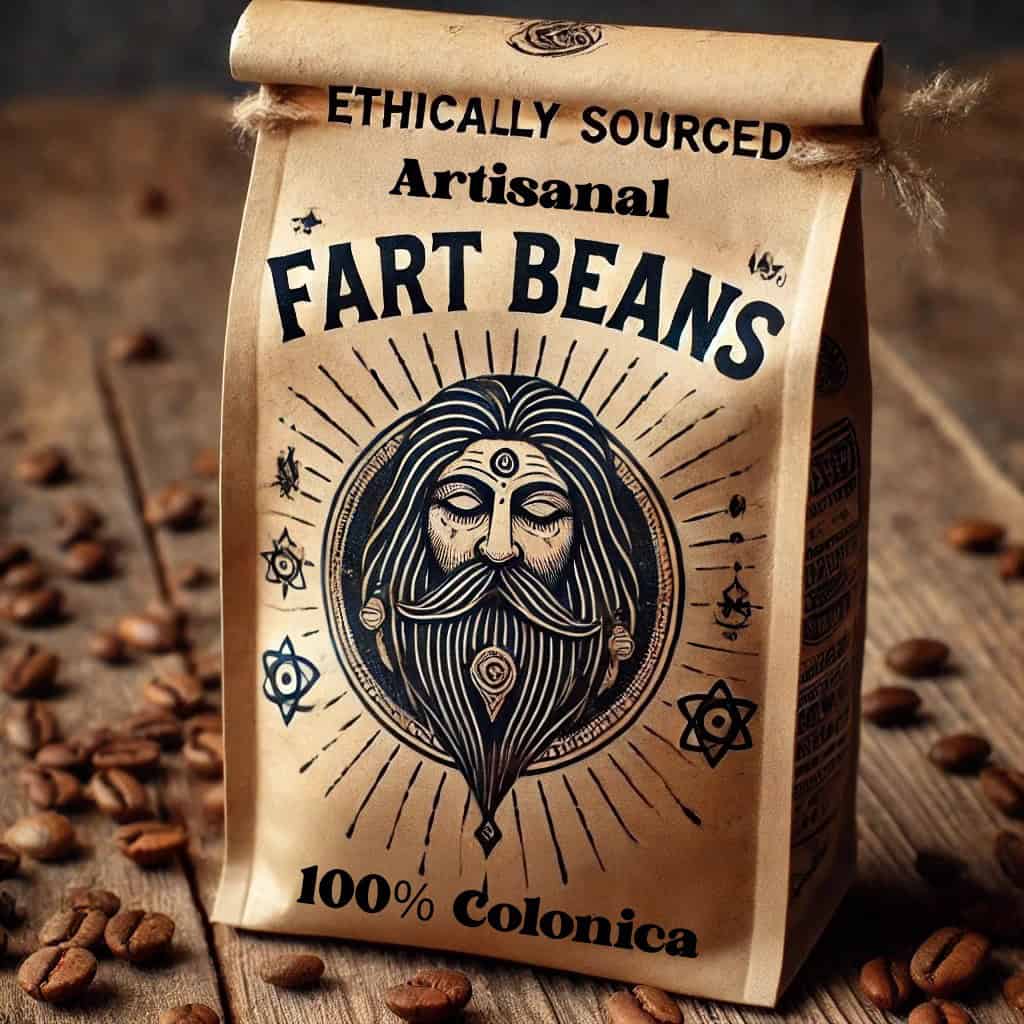
A self-proclaimed “coffee shaman” from Portland has shaken up the specialty coffee world by introducing what he calls “the purest, most personal expression of coffee craftsmanship”—beans fermented using his own digestive process.
The brew, branded as “Ethically Sourced, Artisanal Fart Beans,” has already attracted a cult following among conscious consumers, hipster influencers, and people willing to pay $50 for anything labeled ’small batch.’
“It’s Not Just Coffee—It’s a Reflection of My Inner Self”
The mastermind behind this deeply personal coffee experience is Sage “Sunbeam” Florenzo, a 37-year-old former barista, self-trained energy healer, and proud owner of a handwoven Indian throw, which he wears exclusively as a skirt.
Florenzos’ unique coffee process is, in his words, “a journey, not a product.”
“I wanted to take coffee back to its most authentic roots—to a place where the beans have truly bonded with their maker,” Florenzo said while grinding his latest batch with a stone pestle he claims was blessed by a Tibetan monk.
The process, which he refers to as “Gastro-Infused Digestive Fermentation” (GIDF), involves:
1. Consuming a diet of exclusively organic coffee cherries to ensure “optimal flavor extraction at the molecular level.”
2. Allowing his body to naturally ferment the beans through what he calls “sacred gastro-alchemy.”
3. Extracting the beans post-digestion and freeze-drying them using an ancient technique (his roommate’s dehydrator).
4. Hand-roasting them over a sustainable flame, sourced from a “non-hierarchical fire” he built using only ethically fallen twigs.
“Every cup contains a piece of me—literally,” Florenzo explains. “You don’t just taste the coffee. You taste the journey.”
A ‘Sustainably Sourced’ Process No One Asked For
While traditional coffee beans are processed through industrial methods or animal digestion (like civet coffee), Florenzo believes his process is far superior, since it removes “exploitative intermediaries” like farm workers and roasters.
“This is direct trade at its most direct,” he says. “No middlemen, no corporations. Just me, my gut, and the beans.”
He insists the method is “zero-waste, carbon-neutral, and fully aligned with the cosmic digestive cycle.”
Critics, however, argue that this isn’t how coffee—or literally anything—should be made.
“I mean, at least civets don’t post about it on Instagram,” said one skeptical coffee shop owner.
The Tasting Notes: ‘Complex, Earthy, and Deeply Personal’
According to Florenzo’s devoted customers, the coffee’s flavor profile is unlike anything else on the market.
One early supporter, vegan lifestyle blogger Moonbeam Valencia, described it as:
“A rich, multi-layered experience. You can really taste the nutritional journey of the bean—there’s a certain… depth. Almost primal. Also, my roommate moved out after I brewed it, so now I have space for a meditation corner.”
Others have noted “a distinct, lingering finish,” while one online reviewer compared it to “burnt incense, regret, and mild stomach distress.”
Despite mixed reactions, the Fart Bean movement is gaining traction, with boutique cafés in Brooklyn, Berlin, and San Francisco scrambling to get exclusive fermentation rights.
Next Steps: Expansion, Canned Nitro Brews, and a Netflix Docuseries
Following unexpected demand, Florenzo has announced plans to scale up production, including:
✅ “Micro-batch” Fart Bean Subscription Boxes (each batch personally hand-processed in his home).
✅ A Canned Nitro Version, featuring “extra carbonation for maximum aroma.”
✅ A Masterclass on Digestive Coffee Fermentation, priced at $799, with an optional $299 add-on for ‘spiritual roasting guidance.’
Additionally, streaming platforms are reportedly bidding on a Netflix docuseries, tentatively titled “The Beans Within: One Man’s Journey to Coffee Nirvana.”
For now, customers eager to experience the intimate, artisanal depths of Florenzo’s brew can place an order through his Etsy page, where 8oz bags are available for $85 plus shipping.
When asked if he was worried about health regulations, Florenzo simply smiled.
“They tried to shut me down once,” he said. “But bureaucracy can’t regulate the soul.”
This is satire, of course. The real world is nothing like that…
But if you want to see how things actually work, here are some totally real, absolutely normal links that inspired this story:
The satirical narrative here draws inspiration from real-world practices in the coffee industry, particularly the production of kopi luwak (civet coffee), where coffee cherries are consumed and excreted by civets before processing. This method has garnered attention due to ethical concerns surrounding animal welfare. Here are some real-world articles that provide context: https://en.wikipedia.org/wiki/Kopi_luwak
1. Animal Welfare Issues in Kopi Luwak Production: Investigations have revealed that civets are often confined to small cages and subjected to poor diets to produce kopi luwak, leading to high mortality rates and ethical concerns. https://en.wikipedia.org/wiki/Kopi_luwak
2. Ethical Considerations and Consumer Awareness: The rise in demand for kopi luwak has led to intensive farming practices that are harmful to civets, prompting discussions about the ethics of consuming such products. https://spca.org.sg/campaigns/issues-relating-to-kopi-luwak/
3. Health Risks Associated with Animal-Processed Coffee: There are concerns that the production of kopi luwak could pose health risks, including the potential to brew new pandemics due to the conditions in which civets are kept. https://investigations.peta.org/kopi-luwak-coffee-cruelty/
4. Authenticity and Fraud in the Kopi Luwak Market: The high price of kopi luwak has led to fraudulent practices, with some products labeled as wild-sourced despite being produced under unethical conditions. https://en.wikipedia.org/wiki/Kopi_luwak
These articles shed light on the complexities and ethical debates within the specialty coffee industry, particularly concerning animal welfare and consumer responsibility.
For a visual understanding of traditional kopi luwak production, you might find this video informative:








